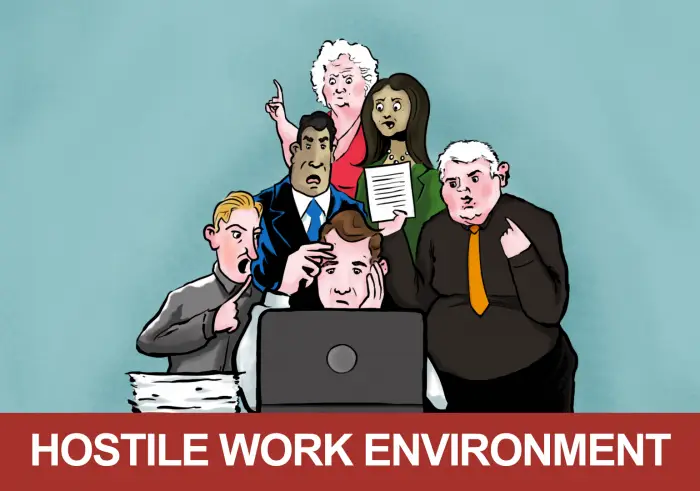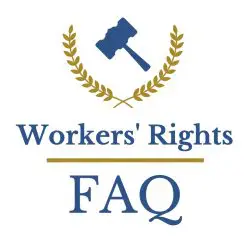What is a Hostile Work Environment?
Your hostile work environment questions, answered
We’ve all heard horror stories about bad bosses and toxic coworkers. Backstabbing, spreading rumors, and harassment can make it impossible to get your job done.
But when does it cross the line into a hostile work environment? And when do you need a hostile work environment attorney?
Employment laws protect your right to a workplace free from harassment and hostile conduct. But before you can protect your rights, you have to understand them.
What is a toxic work environment? And how do you prove a hostile work environment?
Keep reading for answers to all of your hostile workplace questions.
What is a hostile work environment?
Bullying at work is not okay. But a rude boss or negative coworker doesn’t necessarily meet the legal definition of a hostile work environment. Instead, a hostile work environment requires illegal harassment and behavior that affects your ability to do your job.
Employers have a responsibility to prevent hostile or toxic workplaces. Employees can sue if their rights have been violated.
If offensive behavior, harassment, or hostile conduct makes it hard to do your work, you may have a hostile work environment case.
What does hostile work environment mean legally? A toxic work environment must meet certain standards to violate the law. That means an irritating and abrasive coworker might qualify – or might not.
What behaviors are considered criteria for a hostile work environment?
You may wonder whether the behaviors you’ve witnessed count as a toxic work environment. For example, are bosses allowed to yell at you? Is bullying at work legal? And what is hostile harassment?
Legally, offensive behaviors must affect the victim’s ability to work effectively and they must target a protected group. In individual cases, courts must decide which behaviors create a toxic work environment.
Sexually explicit images or remarks, racist slurs, or religious-based harassment can all create a hostile workplace.
However, if severe hostility does not target a protected group, it does not meet the qualifications for a hostile work environment lawsuit.
What qualifies as a hostile work environment?
Many employees don’t know what qualifies as a hostile work environment. So what qualifies as a hostile workplace? And what is a toxic work environment?
A mean or petty boss might make your workplace uncomfortable, but it’s not enough to legally qualify as a hostile workplace. So if a bad boss alone isn’t enough, what qualifies as a hostile work environment?
Hostile work environment laws protect certain groups. When harassment targets a particular group, it can violate employment laws.
For example, offensive comments or conduct that targets a race, religion, gender, or disability status can create a hostile work environment.
What constitutes a hostile work environment?
To qualify as a hostile workplace, the behavior or conduct must meet certain legal standards.
The offensive behavior or harassment must target a protected group under federal, state, or local laws. Everyone falls into one of these groups based on their sex, race, age, religion, or national origin.
A boss who yells at you does not meet the legal standard. However, a boss who makes offensive comments about women, Black people, Muslims, or Asians can poison the workplace – even if you are not personally a member of one of those groups.
As for what behaviors are considered criteria for a toxic work environment, it varies by location. In some states, a single offensive remark can rise to the level of a hostile environment.
What is the definition of a hostile work environment?
Legally, a hostile work environment occurs when offensive behavior or conduct targeting a protected class disrupts work or harms an employee’s career progress.
Under federal law, workplace harassment must be severe or pervasive to qualify. State and local laws often provide additional protections. In New York, for example, harassment must exceed a “petty slight” or “trivial inconvenience” to qualify.
During a hostile workplace lawsuit, courts must decide what is intimidating behavior and what is harassing behavior. This varies depending on the facts of the case. A hostile work environment attorney can provide guidance based on your local laws.
What is an example of a hostile work environment?
The hostile work environment definition covers many offensive and toxic behaviors. Examples of hostile work environment can include sexual comments, offensive images, and racial slurs. What behaviors are considered criteria for a hostile work environment?
Hostile work environment examples include:
- A coworker who repeatedly makes sexual comments to another employee
- Offensive images or comments shared in the office or sent by email
- A boss taunting an employee for their religious beliefs
- A vendor who uses racial slurs
- Blocking someone from leaving their office or workspace
- A group of employees making racist or sexist jokes in the break room
- Sexual advances, unwelcome touching, or inappropriate comments on someone’s physical appearance
- Any threatening or demeaning behavior
Any behavior that makes someone feel unsafe, intimidated, threatened, or unwelcome in the workplace can create a hostile workplace. Courts ultimately determine whether offensive conduct reaches the standard of a hostile environment.
Can I sue my employer for creating a hostile work environment?
Can you sue your employer for a hostile work environment? The answer is simple: yes. Employees have a right to work in a professional environment free from harassment.
When you experience harassment at work, you’re left wondering how to deal with a toxic work environment. An employment lawyer can help you decide whether to file a lawsuit. Employment lawyers can also negotiate a settlement for your hostile work environment lawsuit.
Anyone can create a hostile work environment, not just your boss. A coworker, a supervisor in another department, and even non-employees like vendors can create a toxic workplace.
However, before considering a lawsuit, make sure your workplace meets the legal definition for a hostile environment. In order to meet the legal standard, offensive conduct must target a protected group.
For example, hostile comments about a religion, gender, race, national origin, or disability status violate the law. Can you sue for workplace bullying? Only if it targets a protected group.
Can I sue for hostile work environment after I quit?
If you quit your job due to harassment or a toxic workplace, you can still sue your employer. It’s harder to prove a hostile work environment if you quit, but it’s not impossible.
Constructive discharge means that you were forced to quit because of terrible work conditions. The courts have ruled that “intolerable” conditions can justify quitting. There isn’t a clear standard for what counts as intolerable, though.
A hostile work environment attorney can help you determine whether you have a case. Contact an employment lawyer for a free consultation.
Learn more about forced resignation with our Guide to Constructive Discharge.
How much can I sue for hostile work environment?
If you’re considering filing a lawsuit, you’ve likely wondered how much is a hostile work environment settlement?
The amount you can win in a hostile work environment lawsuit depends on many factors. The severity of the hostile environment influences settlement amounts. Lost wages and emotional distress also factor into the amount of a hostile work environment settlement.
When considering how to win a hostile work environment lawsuit, contacting an employment lawyer can help you build a stronger case and secure a fair settlement.
Learn more about suing for emotional distress damages.
Can you sue your employer for emotional distress?
Yes, you can sue your employer for emotional distress caused by workplace harassment, discrimination, or a toxic work environment.
What is emotional distress? Emotional distress is mental anguish caused by offensive, threatening, or demeaning behavior at work. Emotional distress damages compensate employees for their emotional pain and suffering.
If a supervisor causes emotional distress or a coworker recklessly or intentionally inflicts emotional distress, you may have a case. A hostile work environment lawyer can help you decide whether to file a lawsuit.
Learn more about emotional distress damages.
Can an independent contractor sue for a hostile work environment?
Hostile work environment protections for independent contractors or freelancers are more complicated, unfortunately. While employment laws cover traditional employees, they do not extend to independent contractors in every state.
However, some independent contractors can sue for a toxic work environment.
In New York, independent contractor rights include harassment protections. The Freelance Isn’t Free Act also protects freelancers from harassment and retaliation. Employment lawyers who specialize in independent contractor rights can provide additional legal guidance.
What are signs of a hostile work environment?
A hostile environment is any workplace negatively affected by offensive, toxic, or hostile behavior. Aggressiveness, offensive comments, and verbal attacks are all signs of a hostile work environment.
However, in a legal sense, a hostile environment only exists under certain circumstances. The offensive conduct must target a group based on their race, sex, gender identity, religion, age, or national origin. Laws against hostile work environments only cover these cases.
In some states, hostile work environment laws also cover harassment targeting someone’s marital status, parental status, or military status.
The harassment must also affect the victim’s ability to work.
Do I have a case for hostile work environment?
When you witness or experience harassment in the workplace, you may have a hostile work environment case.
If offensive conduct affects your ability to do your job, you can file a lawsuit. Even if you were not the target of the harassment, you may have a case. For example, men can file a lawsuit about sexual harassment targeting women in their workplace.
Similarly, a white employee can file a case if racial slurs targeting other groups create a toxic environment.
You might be wondering how to prove a hostile work environment. Contact an employment lawyer to find out if you have a case and learn more about how to win a hostile work environment lawsuit.
How to prove a hostile work environment
Read more about hostile work environment protections or contact an employment lawyer to ask about your case.
Charles Joseph offers free, confidential consultations to victims of hostile workplaces. Charles Joseph brings over two decades of experience as a hostile work environment attorney and founder of Joseph & Kirschenbaum. His firm has recovered over $200 million for clients.
